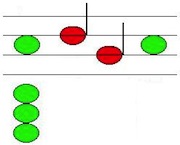
HARMONIC EXPANSIONS
CHAPTER 2: NONHARMONIC TONES
2.12 Changing Tones
 |
 |
 |
The above video shows the beginning of the second movement of Kuhlau's Sonatina Op.20 No.1 where, in the second complete measure, a B-natural and D appear between two C's. This expansion of the first inversion dominant triad is accomplished by a pair of nonharmonic tones called changing tones (CT's). The melodic movement is a descent from C by step to the nonchord tone B-natural, a rise by third to the nonchord tone D, and a descent by step resolving back to the original chord tone, C.
|
In general changing tones leave a chord tone by step in either direction, move to another nonchord tone by third in the opposite direction, and resolve to the original note by step. Notice that in the graphic to the right the notes move in directions opposite to those in the sonatina at the top of the page. |

|
| In four voices On page 1.7, expanding the dominant with a consonant skip resulted in changing tones. Together with the preparation and resolution, this figure spanned the whole phrase. On this page changing tones will expand only parts of the fundamental progression: the initial tonic and dominant. | |
|
In the video on the left the first phrase shows changing tones expanding the initial tonic with a descending third. The second phrase shows changing tones expanding the dominant with an ascending third. |
|
|
In the following phrase, from Beethoven's Sonata Op.7, the pianist plays a series of three changing tones. | |
 |
 |
 |
 |
Comments? Click here. |



